The Internal Structure of Yellow Cuboid Diamonds from Alluvial Placers of the Northeastern Siberian Platform
Abstract
:1. Introduction
2. Results
2.1. Morphological Features
2.2. Internal Structure
2.2.1. Optical Microscopy
2.2.2. X-ray Topography (XRT)
2.2.3. Electron Backscatter Diffraction (EBSD)
3. Discussion
4. Methods
5. Conclusions
Acknowledgments
Author Contributions
Conflicts of Interest
References
- Harrison, E.R.; Tolansky, S. Growth history of a natural octahedral diamond. Proc. R. Soc. Lond. A 1964, 279, 490–496. [Google Scholar] [CrossRef]
- Suzuki, S.; Lang, A.R. Occurrences of facetted re-entrants on rounded growth surfaces of natural diamonds. J. Cryst. Growth 1976, 34, 29–37. [Google Scholar] [CrossRef]
- Lang, A.R. Glimpses into the growth history of natural diamonds. J. Cryst. Growth 1974, 24, 108–115. [Google Scholar] [CrossRef]
- Varshavsky, A.V. Anomalous Birefringence and Internal Morphology of Diamond; Nauka: Moscow, Russia, 1968; p. 92. (In Russian) [Google Scholar]
- Orlov, Y.L. The Mineralogy of Diamond; John Wiley: New York, NY, USA, 1977; p. 233. [Google Scholar]
- Gurney, J.J.; Helmstaedt, H.H.; Richardson, S.H.; Shirey, S.B. Diamonds through time. Econ. Geol. 2010, 105, 689–712. [Google Scholar] [CrossRef]
- Harris, J.W. Diamond geology. In The Properties of Natural and Synthetic Diamond; Field, J.E., Ed.; Academic Press: London, UK, 1992; pp. 345–393. [Google Scholar]
- Welbourn, C.M.; Rooney, M.-L.T.; Evans, D.J.F. A study of diamonds of cube and cube-related shape from the jwaneng mine. J. Cryst. Growth 1989, 94, 229–252. [Google Scholar] [CrossRef]
- Howell, D.; Griffin, W.L.; Piazolo, S.; Say, J.M.; Stern, R.A.; Stachel, T.; Nasdala, L.; Rabeau, J.R.; Pearson, N.J.; O’Reilly, S.Y. A spectroscopic and carbon-isotope study of mixed-habit diamonds: Impurity characteristics and growth environment. Am. Miner. 2013, 98, 66–77. [Google Scholar] [CrossRef]
- Sobolev, N.V. Deep Seated Inclusions in Kimberlites and the Problem of the Composition of the Upper Mantle; AGU: Washington, DC, USA, 1977; p. 279. [Google Scholar]
- Meyer, H.O.A. Genesis of diamond—A mantle saga. Am. Miner. 1985, 70, 344–355. [Google Scholar]
- Meyer, H.O.A. Inclusions in diamond. In Mantle Xenoliths; Nixon, P.H., Ed.; Wiley: New York, NY, USA, 1987; pp. 501–522. [Google Scholar]
- Stachel, T.; Harris, J.W. The origin of cratonic diamonds—Constraints from mineral inclusions. Ore Geol. Rev. 2008, 34, 5–32. [Google Scholar] [CrossRef]
- Parfenov, L.M.; Kuzmin, M.I. Tectonics, Geodynamics and Metallogeny of the Territory of the Republic of Sakha (Yakutia); Nauka/Interperiodika: Moscow, Russia, 2001; p. 571. (In Russian) [Google Scholar]
- Grakhanov, S.A.; Shatalov, V.I.; Shtyrov, V.A.; Kychkin, V.R.; Suleimanov, A.M. Diamond Placers of Russia; Akademicheskoe Izd.“Geo”: Novosibirsk, Russia, 2007; p. 454. (In Russian) [Google Scholar]
- Zinchuk, N.N.; Koptil, V.I. Typomorphism of Diamonds in the Siberian Craton; Nedra: Moscow, Russia, 2003; p. 603. (In Russian) [Google Scholar]
- Zinchuk, N.N.; Koptil, V.I.; Boris, E.I.; Lipashova, A.N. Typomorphic features of placer diamonds from the Siberian craton: A principle guide in diamond exploration. Rudy Met. 1999, 3, 18–30. [Google Scholar]
- Afanas’ev, V.P.; Zinchuk, N.N.; Koptil, V.I. Polygenesis of diamonds in connection with the problem of northeastern primary sources of Siberian platform. Dokl. Akad. Nauk 1998, 361, 366–369. [Google Scholar]
- Afanas’ev, V.P.; Lobanov, S.S.; Pokhilenko, N.P.; Koptil’, V.I.; Mityukhin, S.I.; Gerasimchuk, A.V.; Pomazanskii, B.S.; Gorev, N.I. Polygenesis of diamonds in the Siberian platform. Russ. Geol. Geophys. 2011, 52, 259–274. [Google Scholar] [CrossRef]
- Gurney, J.J.; Hildebrand, P.R.; Carlson, J.A.; Fedortchouk, Y.; Dyck, D.R. The morphological characteristics of diamonds from the Ekati property, Northwest Territories, Canada. Lithos 2004, 77, 21–38. [Google Scholar] [CrossRef]
- Posukhova, T.; Kolume, F. Diamonds from placers in Western and Central Africa: A problem of primary sources. Mosc. Univ. Geol. Bull. 2009, 64, 177–186. [Google Scholar] [CrossRef]
- Galimov, E. The relation between formation conditions and variations in isotope composition of diamonds. Geochem. Int. 1985, 22, 118–141. [Google Scholar]
- Shatsky, V.S.; Zedgenizov, D.A.; Ragozin, A.L.; Kalinina, V.V. Diamondiferous subcontinental lithospheric mantle of the northeastern siberian craton: Evidence from mineral inclusions in alluvial diamonds. Gondwana Res. 2015, 28, 106–120. [Google Scholar] [CrossRef]
- Shatsky, V.S.; Zedgenizov, D.A.; Ragozin, A.L.; Kalinina, V.V. Carbon isotopes and nitrogen contents in placer diamonds from the ne siberian craton: Implications for diamond origins. Eur. J. Miner. 2014, 26, 41–52. [Google Scholar] [CrossRef]
- Zedgenizov, D.A.; Ragozin, A.L.; Shatsky, V.S.; Araujo, D.; Griffin, W.L. Fibrous diamonds from the placers of the northeastern Siberian platform: Carbonate and silicate crystallization media. Russ. Geol. Geophys. 2011, 52, 1298–1309. [Google Scholar] [CrossRef]
- Zedgenizov, D.; Rubatto, D.; Shatsky, V.; Ragozin, A.; Kalinina, V. Eclogitic diamonds from variable crustal protoliths in the northeastern siberian craton: Trace elements and coupled δ13C–δ18O signatures in diamonds and garnet inclusions. Chem. Geol. 2016, 422, 46–59. [Google Scholar] [CrossRef]
- Ragozin, A.L.; Zedgenizov, D.A.; Kuper, K.E.; Shatsky, V.S. Radial mosaic internal structure of rounded diamond crystals from alluvial placers of Siberian platform. Miner. Petrol. 2016, 110, 861–875. [Google Scholar] [CrossRef]
- Ragozin, A.L.; Shatskii, V.S.; Zedgenizov, D.A. New data on the growth environment of diamonds of the variety V from placers of the northeastern Siberian platform. Dokl. Earth Sci. 2009, 425, 436. [Google Scholar] [CrossRef]
- Ragozin, A.L.; Shatsky, V.S.; Rylov, G.M.; Goryainov, S.V. Coesite inclusions in rounded diamonds from placers of the northeastern Siberian platform. Dokl. Earth Sci. 2002, 384, 385–389. [Google Scholar]
- Zedgenizov, D.A.; Kalinina, V.V.; Reutsky, V.N.; Yuryeva, O.P.; Rakhmanova, M.I. Regular cuboid diamonds from placers on the northeastern Siberian platform. Lithos 2016, 265, 125–137. [Google Scholar] [CrossRef]
- Lang, A.R. Space-filling by branching columnar single-crystal growth: An example from crystallisation of diamond. J. Cryst. Growth 1974, 23, 151–153. [Google Scholar] [CrossRef]
- Orlov, Y.L.; Bulienkov, N.A.; Martovitsky, V.P. A study of the internal structure of variety III diamonds by x-ray section topography. Phys. Chem. Miner. 1982, 8, 105–111. [Google Scholar] [CrossRef]
- Khokhryakov, A.F.; Pal’yanov, Y.N. The evolution of diamond morphology in the process of dissolution: Experimental data. Am. Miner. 2007, 92, 909–917. [Google Scholar] [CrossRef]
- Howell, D. Strain-induced birefringence in natural diamond: A review. Eur. J. Miner. 2012, 24, 575–585. [Google Scholar] [CrossRef]
- Howell, D.; Piazolo, S.; Dobson, D.; Wood, I.; Jones, A.; Walte, N.; Frost, D.; Fisher, D.; Griffin, W. Quantitative characterization of plastic deformation of single diamond crystals: A high pressure high temperature (HPHT) experimental deformation study combined with electron backscatter diffraction (EBSD). Diam. Relat. Mater. 2012, 30, 20–30. [Google Scholar] [CrossRef]
- Lang, A.R. Causes of birefringence in diamond. Nature 1967, 213, 248–251. [Google Scholar] [CrossRef]
- Tolansky, S. Birefringence of diamond. Nature 1966, 211, 158–160. [Google Scholar] [CrossRef]
- Moore, M.; Lang, A.R. On the internal structure of natural diamonds of cubic habit. Philos. Mag. 1972, 26, 1313–1325. [Google Scholar] [CrossRef]
- Titkov, S.V.; Shiryaev, A.A.; Zudina, N.N.; Zudin, N.G.; Solodova, Y.P. Defects in cubic diamonds from the placers in the northeastern Siberian platform: Results of ir microspectrometry. Russ. Geol. Geophys. 2015, 56, 354–362. [Google Scholar] [CrossRef]
- Authier, A. Contrast of images in X-Ray topography. In Diffraction and Imaging Techniques in Materials Science; Amelinckx, S., Gevers, R., Van Landuyt, J., Eds.; North-Holland: Amsterdam, The Netherlands, 1978; Volume 2, pp. 715–757. [Google Scholar]
- Lang, A.R. Techiques and interpretation in X-ray topography. In Diffraction and Imaging Techniques in Materials Science; Amelinckx, S., Gevers, R., Van Landuyt, J., Eds.; North-Holland: Amsterdam, The Netherlands, 1978; Volume 2, pp. 623–714. [Google Scholar]
- Lang, A.R. The projection topograph: A new method in X-ray diffraction microradiography. Acta Crystallogr. 1959, 12, 249–250. [Google Scholar] [CrossRef]
- Khokhryakov, A.F.; Pal’yanov, Y.N. Evolution of diamond morphology in the processes of mantle dissolution. Lithos 2004, 73, S57. [Google Scholar]
- Sunagawa, I. Growth and morphology of diamond crystals under stable and metastable contitions. J. Cryst. Growth 1990, 99, 1156–1161. [Google Scholar] [CrossRef]
- Chernov, A.A. Stability of faceted shapes. J. Cryst. Growth 1974, 24–25, 11–31. [Google Scholar] [CrossRef]
- Kuper, K.E.; Zedgenizov, D.A.; Ragozin, A.L.; Shatsky, V.S. X-ray topography of natural diamonds on the VEPP-3 SR beam. Nucl. Insrum. Meth. A 2009, 603, 170–173. [Google Scholar] [CrossRef]
- Humphreys, F.J. Review grain and subgrain characterisation by electron backscatter diffraction. J. Mater. Sci. 2001, 36, 3833–3854. [Google Scholar] [CrossRef]
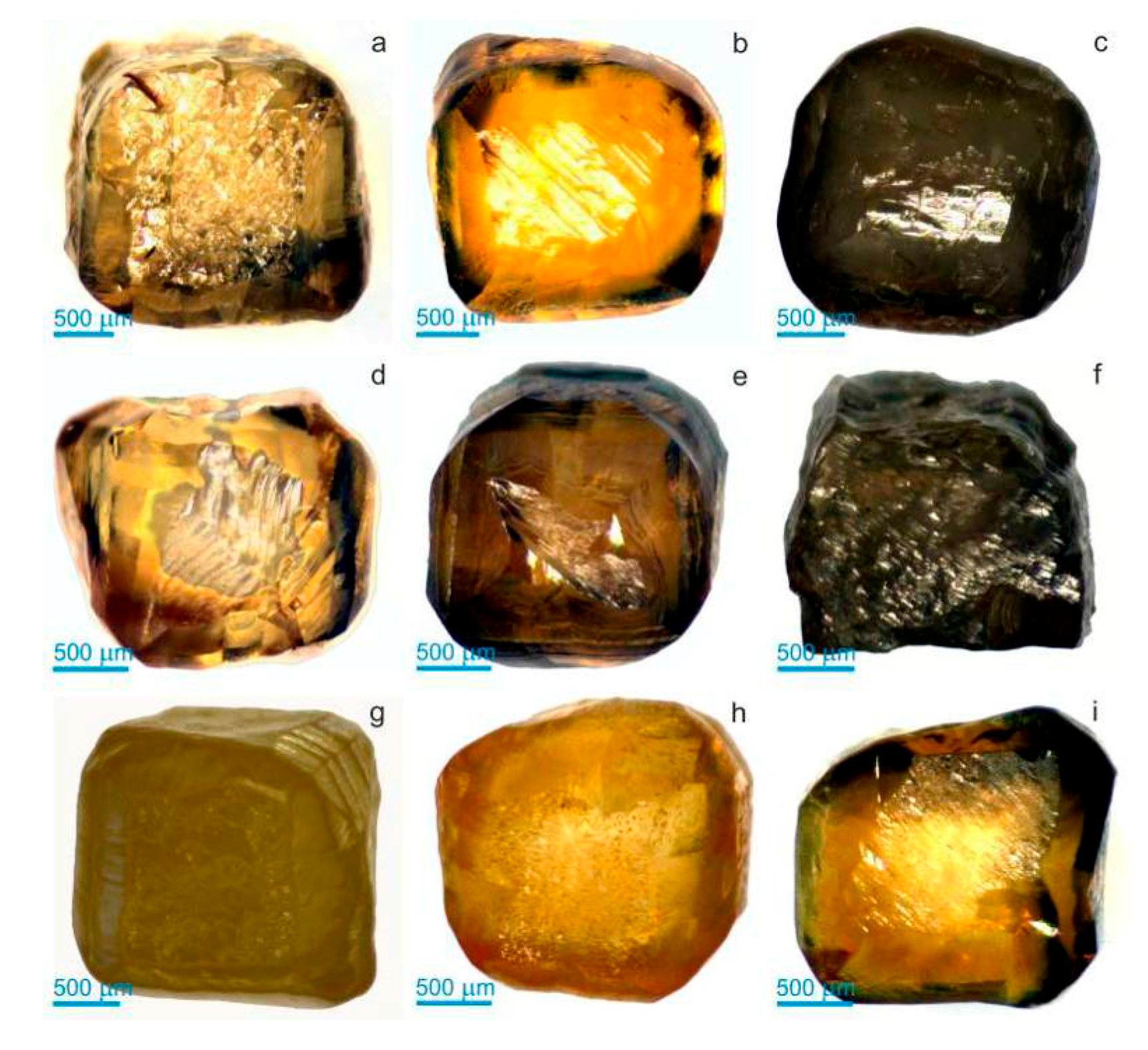
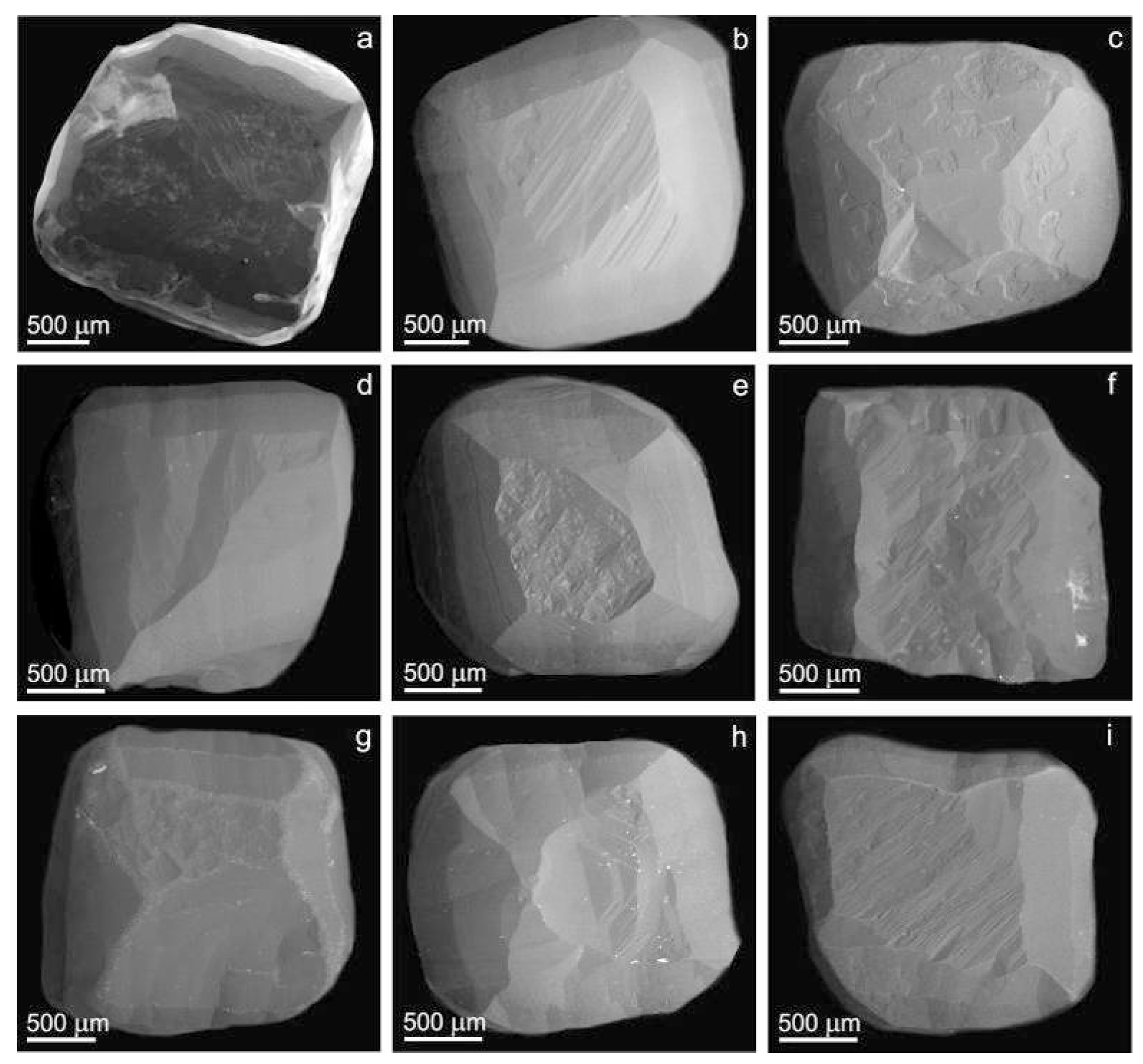
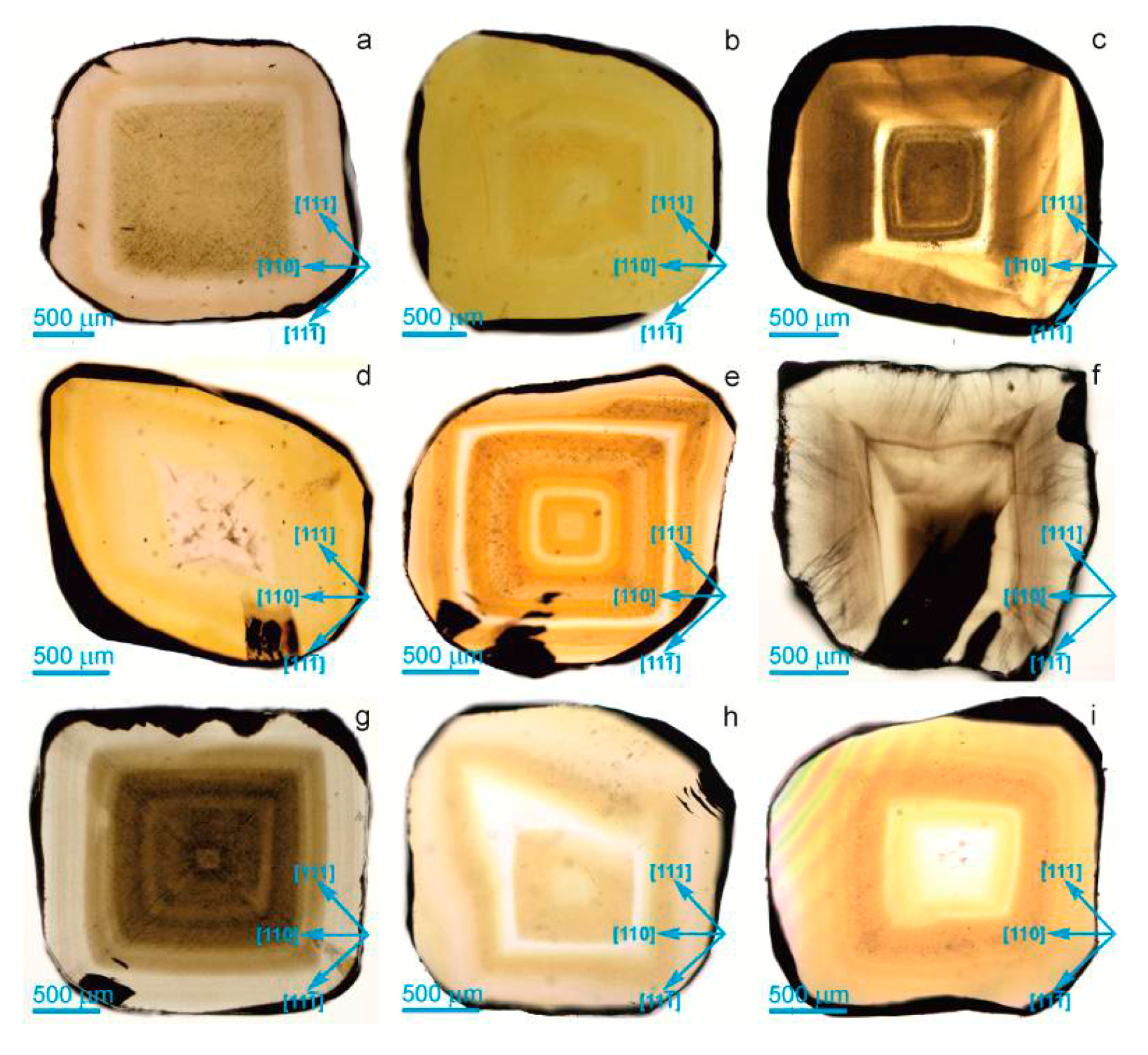
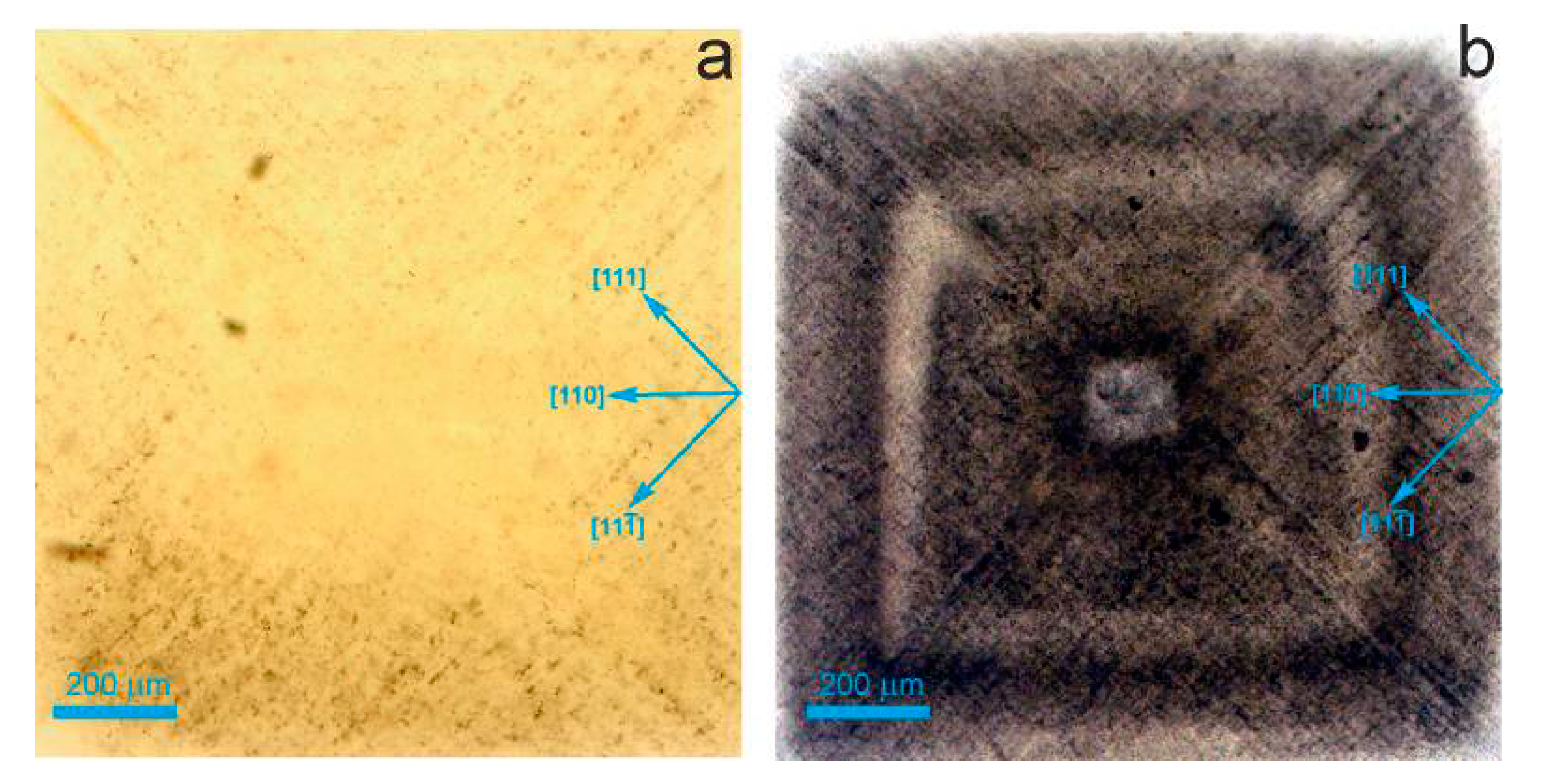
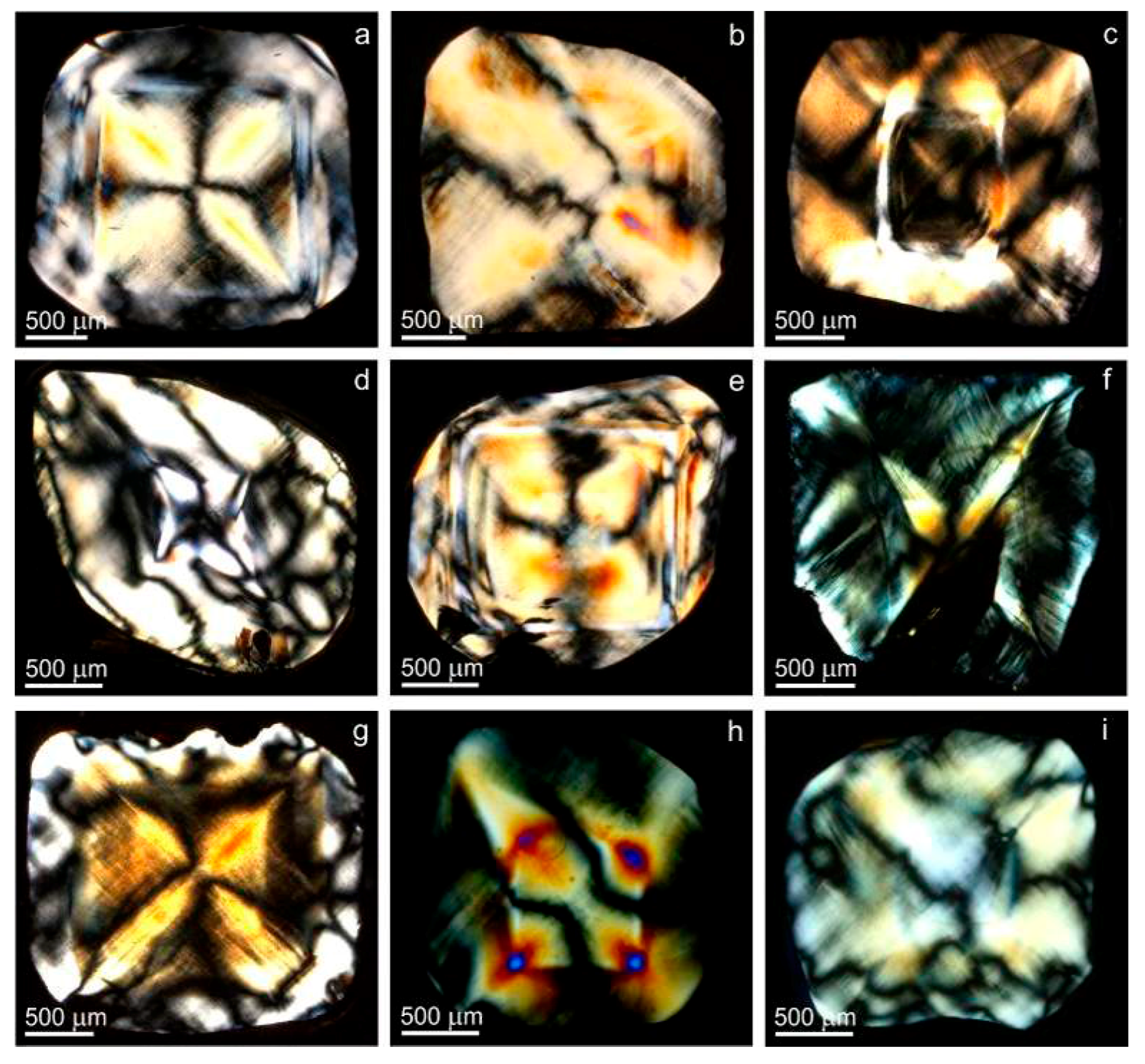
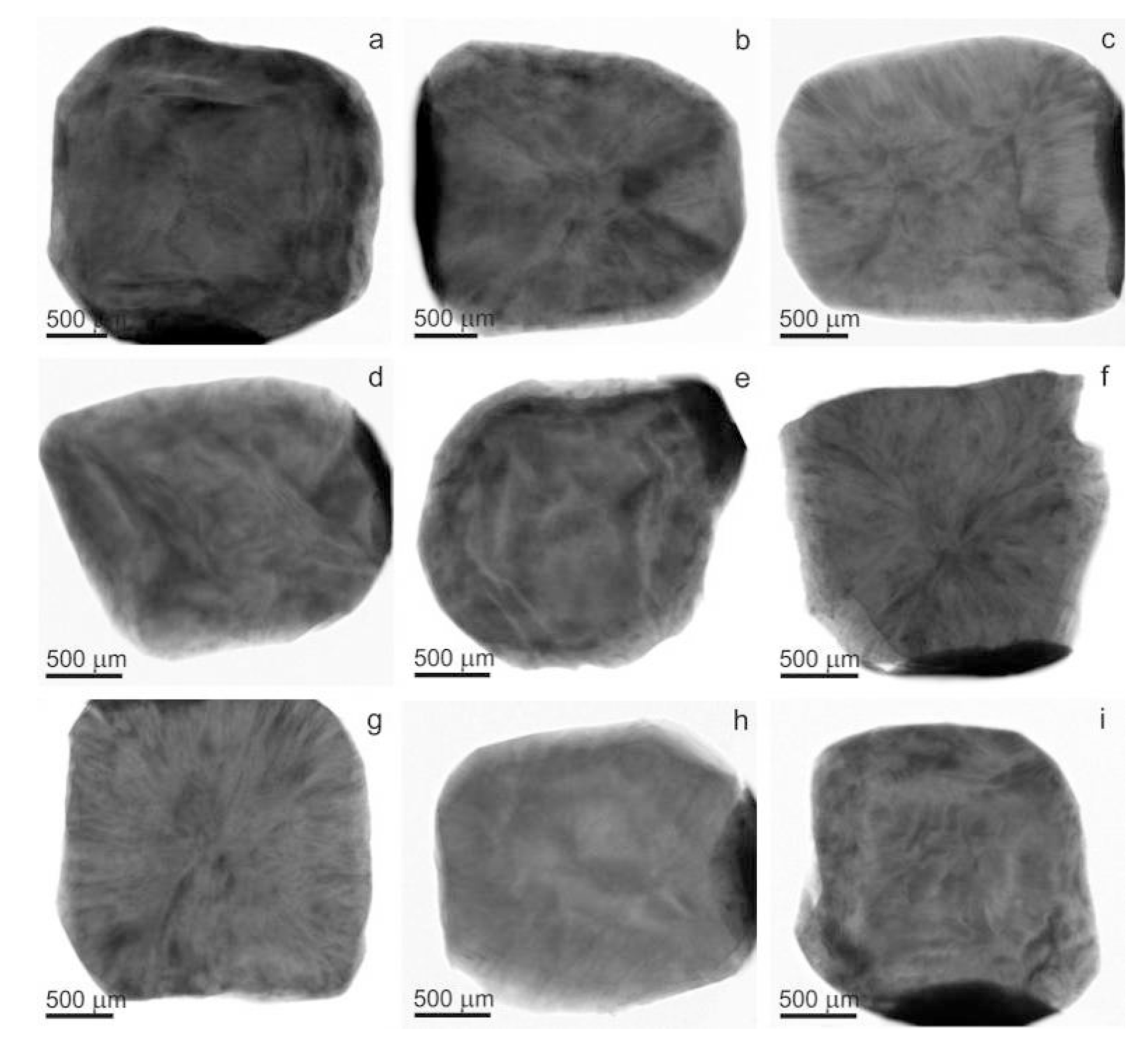
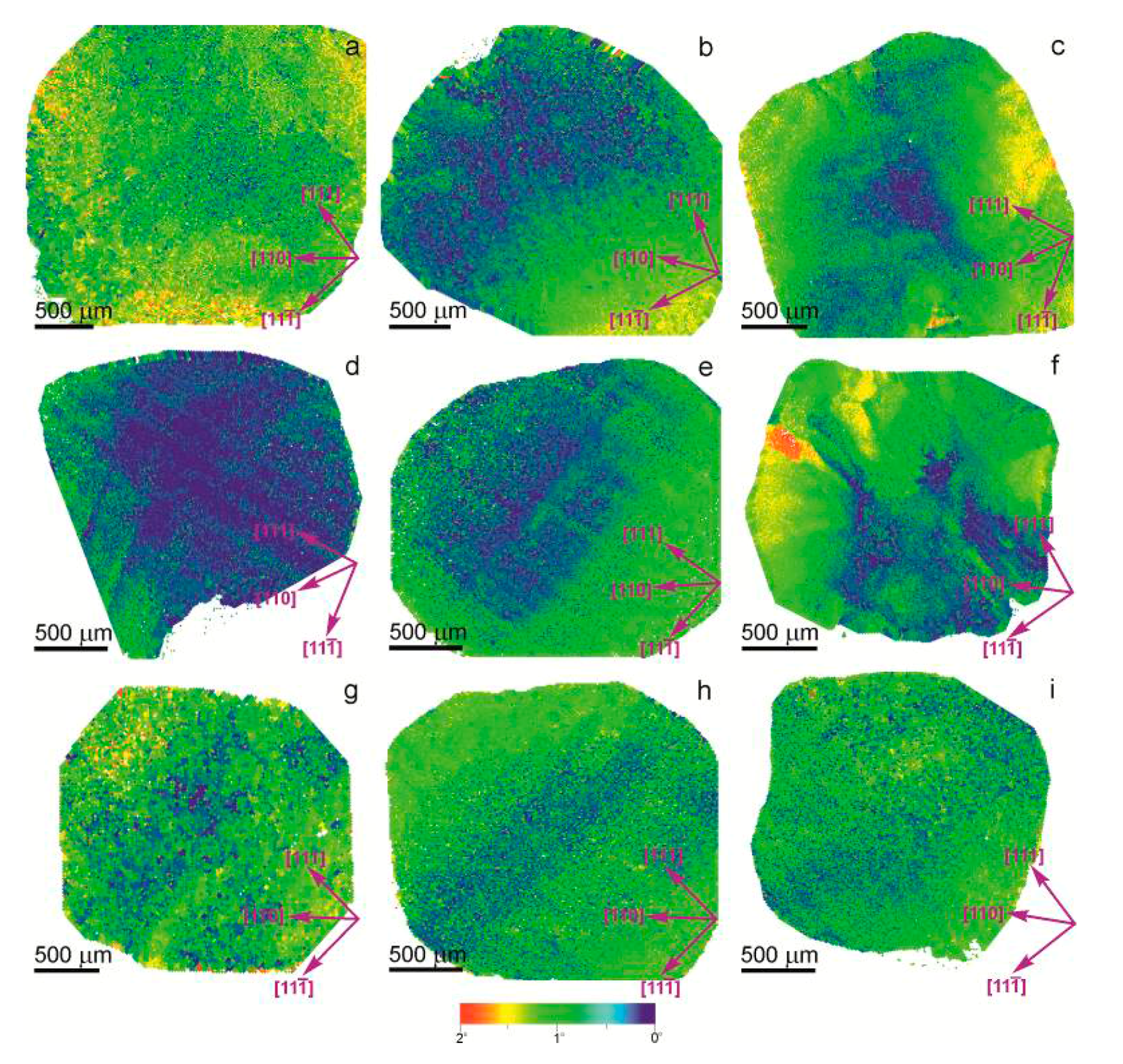
© 2017 by the authors. Licensee MDPI, Basel, Switzerland. This article is an open access article distributed under the terms and conditions of the Creative Commons Attribution (CC BY) license (http://creativecommons.org/licenses/by/4.0/).
Share and Cite
Ragozin, A.; Zedgenizov, D.; Kuper, K.; Kalinina, V.; Zemnukhov, A. The Internal Structure of Yellow Cuboid Diamonds from Alluvial Placers of the Northeastern Siberian Platform. Crystals 2017, 7, 238. https://doi.org/10.3390/cryst7080238
Ragozin A, Zedgenizov D, Kuper K, Kalinina V, Zemnukhov A. The Internal Structure of Yellow Cuboid Diamonds from Alluvial Placers of the Northeastern Siberian Platform. Crystals. 2017; 7(8):238. https://doi.org/10.3390/cryst7080238
Chicago/Turabian StyleRagozin, Alexey, Dmitry Zedgenizov, Konstantin Kuper, Viktoria Kalinina, and Alexey Zemnukhov. 2017. "The Internal Structure of Yellow Cuboid Diamonds from Alluvial Placers of the Northeastern Siberian Platform" Crystals 7, no. 8: 238. https://doi.org/10.3390/cryst7080238



